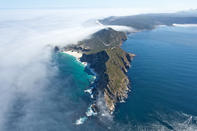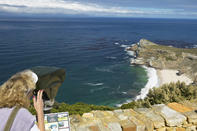South Africa's Weather System
The long, tapering finger of Cape Point may not be the Southern-most tip of mainland Africa - that honour belongs to Cape Agulhas, about 170k’s due East – but why quibble? Cape Point can be regarded as the most dramatic culmination of continent and sea in the world.

And, despite the geographical realities of the situation, I see Cape Point as the metaphorical dot on which the entire Question Mark of Africa precariously balances. With regards to the claim that this is the point where two oceans meet, once again, it’s all in the eye of the beholder.
While those with a cold, logical eye may stick to the cartographer’s opinion that Cape Agulhas marks the divide between the Indian and the Atlantic. But those with a bit of imagination usually put their money on Cape Point as the meeting place of the Oceans. Sadly, both of these propositions are somewhat spurious, as two great oceans don’t meet in a neatly ordered line.
They move and swirl and shift with the seasons. A stronger claim is that Cape Point is the epicentre of South Africa’s weather system. The country’s climate is largely driven by two ocean currents; the cold Benguela Current that slides down the West Coast, and the warm Moçambique current that slips down the East.
These currents advance and retreat with the season, but the Cape Point headland marks the one clear delineation between these two elemental engines.
The Edge of the Earth

So, even today, when you look out from the viewing deck right on the tip of Cape Point, it’s easy to become a Romantic. It’s a grand promontory; a lonely pinnacle of rock thrusting out into the deep sea, defying Neptune to usurp its heights. Standing there on the edge of the Earth, with the deep seas breaking round, it’s easy to imagine that the steep ridges and jagged rocks of the headland are actually the death throes of Adamastor, formed as the legendary giant petrified and sank into the icy waters.
Surrounded by thousands of miles of mighty, suffocating ocean, the hooked claw of Cape Point is a fitting summation to the African continent: wild, imposing and beautiful.
 If you have only a day or two in Cape Town on your South African holiday, this self-drive route around the Cape to Cape Point covers the gre...
If you have only a day or two in Cape Town on your South African holiday, this self-drive route around the Cape to Cape Point covers the gre...